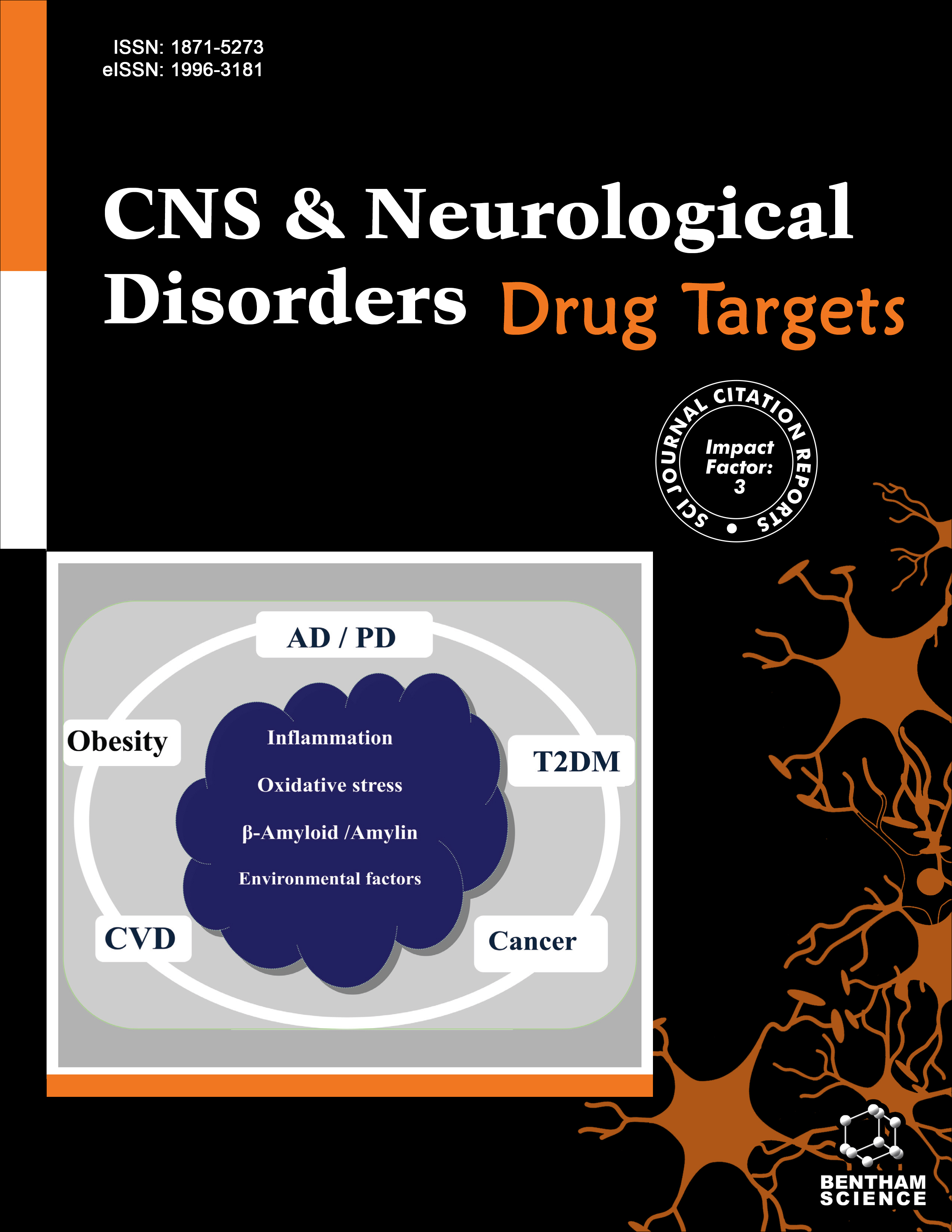- Home
- A-Z Publications
- CNS & Neurological Disorders - Drug Targets (Formerly Current Drug Targets - CNS & Neurological Disorders)
- Issue Home
CNS & Neurological Disorders - Drug Targets (Formerly Current Drug Targets - CNS & Neurological Disorders) - Current Issue
Volume 24, Issue 5, 2025
-
-
Unravelling the Role of Tyrosine and Tyrosine Hydroxylase in Parkinson’s Disease: Exploring Nanoparticle-based Gene Therapies
More LessAuthors: Satya Eswari Jujjavarapu and Arnav MishraParkinson’s disease (PD) is a neurodegenerative disorder that results from the progressive loss of neurons in the brain followed by symptoms such as slowness and rigidity in movement, sleep disorders, dementia and many more. The different mechanisms due to which the neuronal degeneration occurs have been discussed, such as mutation in PD related genes, formation of Lewy bodies, oxidation of dopamine. This Read More
-
-
-
The Potential Role of Dopamine Pathways in the Pathophysiology of Depression: Current Advances and Future Aspects
More LessAuthors: Arzoo Pannu and Ramesh K. GoyalDepression is a serious mental health disorder that impacts more than 350 million individuals globally. While the roles of serotonin and norepinephrine in depression have been extensively studied, the importance of dopaminergic pathways—essential for mood, cognition, motor control, and endocrine function—often gets overlooked. This review focuses on four major dopamine (DA) circuits: the mesolimbic (MLP) Read More
-
-
-
Foreign Contaminants Target Brain Health
More LessAuthors: Uma Agarwal, Arzoo Pannu and Rajiv Kumar TonkNeurodisease, caused by undesired substances, can lead to mental health conditions like depression, anxiety and neurocognitive problems like dementia. These substances can be referred to as contaminants that can cause damage, corruption, and infection or reduce brain functionality. Contaminants, whether conceptual or physical, have the ability to disrupt many processes. These observations motivate us to investigat Read More
-
-
-
Valproic Acid and Celecoxib Enhance the Effect of Temozolomide on Glioblastoma Cells
More LessAuthors: Oleg Pak, Aleksandra Kosianova, Sergei Zaitsev, Aruna Sharma, Hari Sharma and Igor BryukhovetskiyIntroductionGlioblastoma (GB) is one of the deadliest human brain tumors. The prognosis is unfavorable, chemotherapy with temozolomide (TMZ) may extend the survival period for a patient. The paper aims to evaluate the survival rates among relapsing GB patients, who have been treated with valproic acid (VPA), and to study its effect on tumor cells when combined with TMZ and celecoxib (CXB).Materials and MethodsThe r Read More
-
-
-
Anti-neuroinflammatory and Neuroprotective Effects of T-006 on Alzheimer’s Disease Models by Modulating TLR4-Mediated MyD88/NF-κB Signaling
More LessAuthors: Haiyun Chen, Xiao Chang, Jiemei Zhou, Guiliang Zhang, Jiehong Cheng, Zaijun Zhang, Jieyu Xing, Chunyan Yan and Zheng LiuIntroductionNeuroinflammation derived from the activation of the microglia is considered a vital pathogenic factor of Alzheimer's Disease (AD). T-006, a tetramethylpyrazine derivative, has been found to alleviate cognitive deficits via inhibiting tau expression and phosphorylation in AD transgenic mouse models. Recently, T-006 has been proven to dramatically decrease the levels of total Amyloid β (Aβ) peptide and Glial Read More
-
-
-
Nadolol Attenuates Brain Cell Ferroptosis in Ischemic Stroke Rats by Targeting the HOIL-1/IRP2 Pathway
More LessAuthors: Xiao-Yan Yang, Wen-Jun Zhu, Di- Chen, Dan Peng, Jun Peng, Zhi-Jun Zhou and Xiu-Ju LuoIntroductionHeme-oxidized iron regulatory protein 2 (IRP2) ubiquitin ligase-1 (HOIL-1) is believed to contribute to the ubiquitination of IRP2, which facilitates the transcription of transferrin receptor 1 (TfR1) while preventing the transcription of ferroportin-1 (FPN-1). Bioinformatics analysis predicts that nadolol (a β-blocker) interacts with the HOIL-1.MethodsThe present study is intended to explore whether nadolol suppresse Read More
-
Volumes & issues
-
Volume 24 (2025)
-
Volume 23 (2024)
-
Volume 22 (2023)
-
Volume 21 (2022)
-
Volume 20 (2021)
-
Volume 19 (2020)
-
Volume 18 (2019)
-
Volume 17 (2018)
-
Volume 16 (2017)
-
Volume 15 (2016)
-
Volume 14 (2015)
-
Volume 13 (2014)
-
Volume 12 (2013)
-
Volume 11 (2012)
-
Volume 10 (2011)
-
Volume 9 (2010)
-
Volume 8 (2009)
-
Volume 7 (2008)
-
Volume 6 (2007)
-
Volume 5 (2006)
Most Read This Month Most Read RSS feed
Article
content/journals/cnsnddt
Journal
10
5
false
en

Most Cited Most Cited RSS feed
-
-
A Retrospective, Multi-Center Cohort Study Evaluating the Severity- Related Effects of Cerebrolysin Treatment on Clinical Outcomes in Traumatic Brain Injury
Authors: Dafin F. Muresanu, Alexandru V. Ciurea, Radu M. Gorgan, Eva Gheorghita, Stefan I. Florian, Horatiu Stan, Alin Blaga, Nicolai Ianovici, Stefan M. Iencean, Dana Turliuc, Horia B. Davidescu, Cornel Mihalache, Felix M. Brehar, Anca . S. Mihaescu, Dinu C. Mardare, Aurelian Anghelescu, Carmen Chiparus, Magdalena Lapadat, Viorel Pruna, Dumitru Mohan, Constantin Costea, Daniel Costea, Claudiu Palade, Narcisa Bucur, Jesus Figueroa and Anton Alvarez
-
-
-
- More Less

